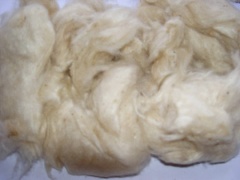Kapok
| Infobox on Kapok | |
|---|---|
| Example of Kapok |  |
| Facts | |
| Origin | See text |
| Stowage factor (in m3/t) | - |
| Humidity / moisture |
|
| Ventilation | See text |
| Risk factors | See text |
Kapok
Description
Ceiba pentandra or the Kapok is a species of tropical trees of the order Malvales and the family Malvaceae (previously separated in the family Bombacaceae), native to Mexico, Central America and the Caribbean, northern South America, and (as the variety Ceiba pentandra var. guineensis) to tropical west Africa.
The word is also used for the fibre obtained from its seed pods. The tree is also known as the Java cotton, Java kapok, or ceiba.
The tree of life grows to 60–70 m tall and has a very substantial trunk up to 3 m in diameter with buttresses.
Kapok is the fine, silkily lustrous fruit fibers from the fruit walls of the capsules, 10 - 20 cm in length and 3 cm in thickness, of the kapok tree.
The kapok hairs, 10 - 35 mm in length, which are plant hairs, are brittle and only spinnable when blended with cotton. The fibers are thermally insulating and water-repellent. Kapok fibers may be white, light gray, yellowish to brown and lustrous.
Application
Kapok fibers can be used as stuffing for upholstery, bedding and for acoustic and thermal insulation. Kapok hairs are not wettable and can thus be used for filling life jackets and life belts because the large, air-filled lumen ensures that the kapok fibers have a low density and good buoyancy. Even after extended immersion in water, buoyancy declines only slightly.
Shipment / Storage
Kapok is transported unpackaged in bales of approx. 90 - 100 kg.
Although kapok is naturally water-resistant, wetting can result in discoloration, mustiness and decay. Kapok may swell by absorbing water vapour, resulting in an increase in volume.
If the product is loaded for shipment in a dry state, it does not have any particular ventilation requirements. Otherwise an air exchange rate of 10 changes/hour (airing) has to be applied.
Risk factors
- Self-heating / Spontaneous combustion
- Moist
- Contamination
- Shrinkage/Shortage
Consult the IMDG Code (International Maritime Dangerous Goods Code) and applicable MSDS sheet(s) for overseas transport advice.











